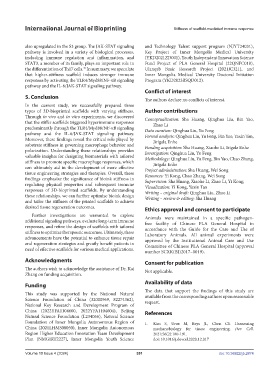Page 359 - IJB-10-4
P. 359
International Journal of Bioprinting Stiffness of scaffold-mediated immune response
also upregulated in the S3 group. The JAK-STAT signaling and Technology Talent support program (NJYT24031),
pathway is involved in a variety of biological processes, Key Project of Inner Mongolia Medical University
including immune regulation and inflammation, and (YKD2021ZD001), Youth Independent Innovation Science
STAT3, a member of its family, plays an important role in Fund Project of PLA General Hospital (22QNFC018),
the differentiation of Th17 cells. In summary, we speculate Ulanqab Basic Research Project (2021JC321), and
49
that higher-stiffness scaffold induces stronger immune Inner Mongolia Medical University Doctoral Initiation
responses by activating the TLR4/Myd88/NF-κB signaling Program (YKD2023BSQD012).
pathway and the IL-6/JAK-STAT signaling pathway.
Conflict of interest
5. Conclusion The authors declare no conflicts of interest.
In the current study, we successfully prepared three
types of 3D-bioprinted scaffolds with varying stiffness. Author contributions
Through in vivo and in vitro experiments, we discovered Conceptualization: Sha Huang, Qinghua Liu, Bin Yao,
that the stiffer scaffolds triggered hyperimmune responses Zhao Li
predominantly through the TLR4/Myd88/NF-κB signaling Data curation: Qinghua Liu, Yu Feng
pathway and the IL-6/JAK-STAT signaling pathway. Formal analysis: Qinghua Liu, Yu Feng, Bin Yao, Yaxin Tan,
Moreover, these findings reveal the critical role played by Jirigala Enhe
substrate stiffness in governing macrophage behavior and Funding acquisition: Sha Huang, Xiaohe Li, Irigala Enhe
polarization. Understanding these relationships provides Investigation: Qinghua Liu, Yu Feng
valuable insights for designing biomaterials with tailored Methodology: Qinghua Liu, Yu Feng, Bin Yao, Chao Zhang,
stiffness to promote specific macrophage responses, which Jirigala Enhe
can ultimately aid in the development of more effective Project administration: Sha Huang, Wei Song
tissue engineering strategies and therapies. Overall, these Resources: Yi Kong, Chao Zhang, Wei Song
findings emphasize the significance of bioink stiffness in Supervision: Sha Huang, Xiaohe Li, Zhao Li, Yi Kong,
regulating physical properties and subsequent immune Visualization: Yi Kong, Yaxin Tan
responses of 3D-bioprinted scaffolds. By understanding Writing – original draft: Qinghua Liu, Zhao Li
these relationships, we can further optimize bioink design Writing – review & editing: Sha Huang
and tailor the stiffness of the printed scaffolds to achieve
desired tissue regeneration outcomes. Ethics approval and consent to participate
Further investigations are warranted to explore Animals were maintained in a specific pathogen-
additional signaling pathways, evaluate long-term immune free facility of Chinese PLA General Hospital in
responses, and refine the design of scaffolds with tailored accordance with the Guide for the Care and Use of
stiffness to optimize therapeutic outcomes. Ultimately, these Laboratory Animals. All animal experiments were
advancements have the potential to enhance tissue repair approved by the Institutional Animal Care and Use
and regeneration strategies and greatly benefit patients in Committee of Chinese PLA General Hospital (approval
need of effective scaffolds for various medical applications.
number SCXK(BJ)2017–0019).
Acknowledgments Consent for publication
The authors wish to acknowledge the assistance of Dr. Kai Not applicable.
Zhang on funding acquisition.
Availability of data
Funding
The data that support the findings of this study are
This study was supported by the National Natural available from the corresponding authors upon reasonable
Science Foundation of China (32000969, 82274362), request.
National Key Research and Development Program of
China (2022YFA1104600, 2022YFA1104604), Beijing References
Natural Science Foundation (L234066), Natural Science
Foundation of Inner Mongolia Autonomous Region of 1. Kim S, Uroz M, Bays JL, Chen CS. Harnessing
China (2021LHMS08050), Inner Mongolia Autonomous mechanobiology for tissue engineering. Dev Cell.
Region Higher Education Innovation Team Development 2021;56(2):180-191.
Plan (NMGIRT2227), Inner Mongolia Youth Science doi: 10.1016/j.devcel.2020.12.017
Volume 10 Issue 4 (2024) 351 doi: 10.36922/ijb.2874

